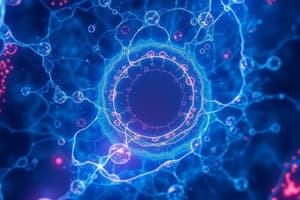Podcast
Questions and Answers
What is the most visible part of a eukaryotic cell?
What is the most visible part of a eukaryotic cell?
nucleus
What is the shape of the nucleus in an animal cell?
What is the shape of the nucleus in an animal cell?
spherical
What is synthesized in the nucleus?
What is synthesized in the nucleus?
nucleic acids
What type of RNA is responsible for converting genetic instructions into functional substances?
What type of RNA is responsible for converting genetic instructions into functional substances?
Red blood cells and platelets retain their nucleus as they mature.
Red blood cells and platelets retain their nucleus as they mature.
What composes the nuclear membrane?
What composes the nuclear membrane?
What is the dense substance inside the nucleus called?
What is the dense substance inside the nucleus called?
What is the function of nuclear pores?
What is the function of nuclear pores?
What is chromatin made up of?
What is chromatin made up of?
Which of the following structures is rich in proteins and nucleic acids?
Which of the following structures is rich in proteins and nucleic acids?
During cell division, the chromatin forms ______.
During cell division, the chromatin forms ______.
Flashcards are hidden until you start studying
Study Notes
Overview of the Nucleus
- The nucleus is the most prominent structure in eukaryotic cells, typically spherical and centrally located.
- It is crucial for synthesizing nucleic acids and storing hereditary information.
- Responsible for generating RNA, which translates DNA genetic instructions into proteins.
- Certain mature cells, like red blood cells and platelets, do not contain a nucleus.
Structure of the Nucleus
-
Nuclear Membrane:
- Composed of two lipid bilayer layers, separating nucleus from cytoplasm.
- Continuous with the endoplasmic reticulum and features ribosomes on its outer layer.
-
Nucleoplasm:
- Dense fluid inside the nucleus, rich in proteins.
- Houses the nucleolus, where ribosomal RNA (rRNA) is synthesized and assembled.
-
Nuclear Pores:
- Selective channels in the nuclear membrane that regulate molecule exchange between the nucleus and cytoplasm.
- Made up of proteins arranged in a radial formation around a central opening.
-
Chromatin:
- Found within the nucleus, consisting of DNA and associated proteins.
- Condenses into chromosomes during cell division, carrying genetic information inherited from parents.
Key Components of the Nucleus
-
Nucleolus:
- The area within the nucleoplasm where rRNA is produced and processed.
-
Nuclear Envelope:
- The double membrane structure that encloses the nucleus and encases the nucleoplasm and chromatin.
-
Nuclear Pores:
- Facilitate the transport of proteins and RNA between the nucleus and cytoplasm.
-
Chromosomes:
- The structures formed by condensed chromatin during cell division, essential for genetic inheritance.
Studying That Suits You
Use AI to generate personalized quizzes and flashcards to suit your learning preferences.




